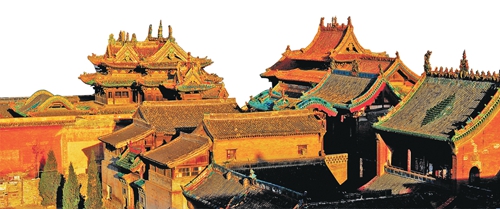 |
Yongle Palace's colorful tiles are a key feature of the site.[Photo provided to China Daily] |
Tourism insiders say that Shanxi is a perfect region to tour and study ancient Chinese architecture because it is home to the largest number of preserved ancient structures in the country.
Jiexiu, a county in central Shanxi, is one such destination that meets tourists' demand for architecture-research tours. It is home to an ancient building complex consisting of eight temples.
Houtu temple, in the northwest of the county seat, is the most renowned among the eight temples.
Historical records show the temple was built more than 1,500 years ago during the Northern Dynasties (386-581). However, the preserved structures were built during a renovation in 1516.
The most remarkable feature of the Taoist temple are the yellow-glazed tiles on its roof, according to Yang Yang, a local researcher.
"There are a number of opinions about Houtu, the name of the temple," Yang said. "Some say it's the name of a person, or a god, while others say it's the title of an official."
Yang asserted that Houtu should be the goddess of earth.
He said he made the judgment from the color of the roof tiles.
"In ancient times, yellow-glazed tiles could only be used for royal residences or temple of important deities," Yang said.
In ancient Chinese, hou was a respectable reference for mother, especially the mother of royal family, and houtu means mother of earth, or earth goddess.
"As China was a farming society for thousands of years, people had a special respect for the goddess of earth." Yang said. "They lifted her to the same status as emperors."
In addition to the yellow-glazed tiles on the main hall and the hall of sacrifice, there are a lot of colorfully glazed structures and ornaments, making the temple "a museum of glazed tiles", Yang said.
The researcher said remains of glazed tiles and ornaments from the Northern Dynasties have been founded in the temple.
"The findings are of great significance to historical studies," Yang said.
"History books show that China began to extensively use color-glazed tiles in buildings since the Northern Dynasties and the relics in the temple should be strong evidence for the history," Yang explained.
The value of the tiles is not limited to their antiqueness. It also lies in their rarity.
"We have identified 'peacock blue' glazed tiles on some of the roofs,"Yang said. "These are the only such variety found in China at present, as the technique for firing peacock blue has been lost for many centuries."
Li Yali contributed to this story.